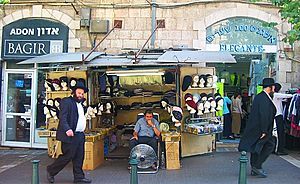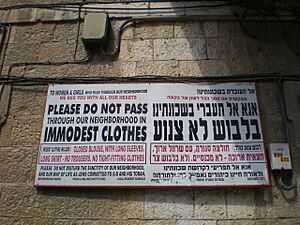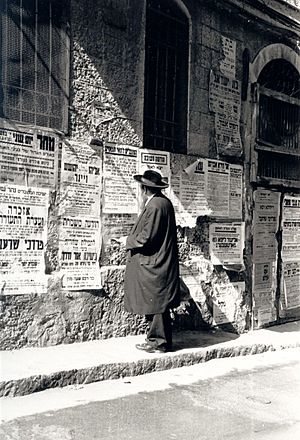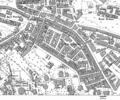Mea Shearim facts for kids
Quick facts for kids
Mea Shearim
מאה שערים
|
|
|---|---|
|
Neighborhood
|
|
 |
|
| Country | |
| City | Jerusalem |
| Founded | 1874 |
Mea Shearim is a very old neighborhood in Jerusalem, Israel. It is known for being home to many Ashkenazi Haredi Jews. This community follows a traditional way of life. The neighborhood was built by members of the Old Yishuv, a Jewish community that lived in the Land of Israel before the modern State of Israel was formed.
Contents
What Does Mea Shearim Mean?
The name Mea Shearim comes from a verse in the Book of Genesis in the Bible. This verse was read during the week the neighborhood was founded. It says that Isaac "reaped a hundredfold" (מאה שערים, mea shearim) from his crops.
There is also a tradition that the community originally had 100 gates. This is another possible meaning for Mea Shearim.
How Mea Shearim Began
Mea Shearim was one of the first Jewish neighborhoods built outside the old walls of Jerusalem's Old City. It was started in 1874 by a group of 100 people who wanted to build new homes.
The Old City was very crowded and had poor living conditions. So, these 100 people bought land outside the walls. They wanted to create a better place to live.
Meir Auerbach, a chief rabbi in Jerusalem, helped start the neighborhood. Conrad Schick, a German architect, drew the first plans for Mea Shearim in 1846.
Building the Neighborhood
Yosef Rivlin, a leader in the Jewish community, worked with a Christian Arab from Bethlehem as contractors. Both Jewish and non-Jewish workers helped build the homes.
Mea Shearim was designed like a courtyard neighborhood. It had a wall around it, and gates that were locked every evening. By 1880, 100 apartments were ready. Families chose their new homes through a lottery.
By the early 1900s, there were 300 houses, a flour mill, and a bakery. Mea Shearim was also the first area in Jerusalem to have street lights.
Life in Mea Shearim Today
Today, Mea Shearim remains a unique neighborhood in Jerusalem. Most of its residents are Haredi Jews, and many belong to Hasidic groups. The streets often feel like a traditional Eastern European village from long ago.
Life here centers around following Jewish law, prayer, and studying religious texts.
Dress and Language
People in Mea Shearim often dress in traditional ways:
- Men wear black coats and black hats. Some groups have different clothing styles.
- Women wear modest, long-sleeved clothes. They cover their hair with wigs, scarves, snoods, hats, or berets. Some Hasidic women wear thick black stockings all year.
- Many men have beards and long sidecurls called pe'ot.
Many residents speak Yiddish in their daily lives. They use Hebrew mainly for prayer and religious study. This is because they believe Hebrew is a sacred language.
Religious Groups in Mea Shearim
Several Hasidic groups have many followers in Mea Shearim. These include Breslov, Slonim, Toldos Aharon, Toldos Avraham Yitzhak, Mishkenos HoRoim, and Satmar. The Pinsk-Karlin dynasty also has its main center here.
The Edah HaChareidis, a religious court that also checks if food is kosher, has its main office in Mea Shearim. The neighborhood is also a strong base for parts of the Neturei Karta movement, which is against Zionism.
Neighborhood Rules and Customs

Signs about "modesty" are placed at every entrance to Mea Shearim. These signs are in both Hebrew and English. They ask visitors to dress respectfully.
Guidelines for Visitors
- Girls and women should wear skirts that reach their knees or longer. They should avoid low necklines or sleeveless tops.
- Boys and men should not wear shorts or sleeveless shirts.
- Tourists are asked not to come in large, noticeable groups.
- During Shabbat (from Friday evening to Saturday evening), visitors should not smoke, take photos, drive, or use mobile phones.
- When entering synagogues, men are asked to cover their heads.
Community Interactions
Sometimes, there are disagreements between some residents and government officials. These can lead to protests where streets are blocked or small fires are set.
A small group called "The Sikrikim" has been known to try and control what books are sold in local shops.
In 2015, an IDF officer was confronted by some residents. This event received national attention and was widely discussed.
Images for kids
See also
 In Spanish: Mea Shearim para niños
In Spanish: Mea Shearim para niños




